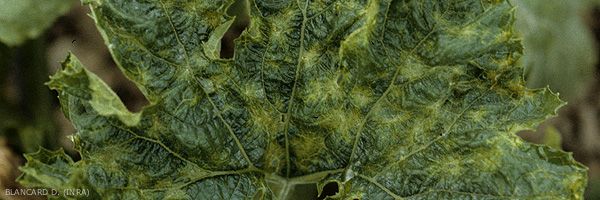
Cucumber mosaic virus (CMV)
Cucumber mosaic virus
(Cucumovirus, Bromoviridae)
CMV has been reported on all continents and in all climates, but its incidence may vary from region to region. It is one of the main viruses of cucurbit crops in temperate and Mediterranean regions. This virus is more rarely encountered on these crops in tropical or subtropical regions, although it is present in the environment, and in particular in weeds. Very common in field cultivation, it is also found under shelter. CMV causes losses that are all the more important the earlier the infections. Watermelon is generally not affected much.
In France , the frequency of CMV infections in cucurbits varies greatly depending on the species, year or region. A survey carried out from 2004 to 2008 in the main French production areas showed that CMV was present in 20% of 2,660 samples analyzed, mainly on cucumber (34% of samples tested), melon (32%), and much less frequently. on zucchini (7%) and squash (5%). Over the 5 years of observation, the frequency of this virus varied from 6% (2006) to 37% (2004) suggesting the existence of cycles for this virus. More generally, it seems that it is less frequent today in France, in particular in the South-East, than it was twenty years ago. However, it remains common in the southwest of France.
CMV is often found in mixed infection with other viruses. Synergies leading to stronger symptoms have been reported in mixed infections with different potyviruses.
CMV was first isolated from cucumber in 1916 in the USA. It is the type species of Cucumoviruses . It is widespread worldwide and has one of the most extensive host ranges in both monocots and dicots. More than 1000 plant species are sensitive to it, and in particular many market garden species (tomatoes, peppers, salads, spinach, etc.), fruit crops (cherry trees, bananas, etc.) and weeds. It is transmitted by many species of aphid, in the non-persistent mode.
A large number of strains of CMV have been described. Depending on their biological (symptomatology, thermosensitivity, etc.), serological and molecular characteristics, these strains are assigned to two main groups (I and II), group I itself being divided into IA and IB.
This virus has a divided genome made up of three single-stranded RNAs of positive polarity. Some isolates have additional satellite RNA that can alter symptom expression.
The viral particles are paraspheric about 29 nm in diameter (Figure 1).
| Figure 1 |
Many viruses cause mosaics in cucurbits, which often makes visual diagnosis difficult. However, the symptoms of CMV in zucchini are quite characteristic and allow rapid identification of the virus. Commercial kits diagnostic ELISA are available as well as primers for molecular diagnosis. Recently, rapid detection kits have been developed: they allow the presence of this virus to be revealed in a few minutes in the field.





